The Notre Dame Fighting Irish are the athletic teams that represent the University of Notre Dame. The Fighting Irish participate in 23 National Collegiate Athletic Association Division I intercollegiate sports and in the NCAA's Division I in all sports, with many teams competing in the Atlantic Coast Conference. Notre Dame is one of only 16 universities in the United States that play Division I FBS football and Division I men's ice hockey. The school colors are gold and blue and the mascot is the Leprechaun. It was founded on November 23, 1887, with football in Notre Dame, Indiana.
History of the Fighting Irish
Moniker
The exact origin of the moniker "Fighting Irish" is unknown and has been the subject of debates and research. It is first attested as early as 1909, and subsequently became more popular in the 1910s, until it became the official nickname in 1927.
The athletes and teams at Notre Dame were known by many different unofficial names throughout the late 19th and early 20th centuries. During the Knute Rockne football era, Notre Dame had several unofficial nicknames, among them the "Rovers", "Domers", and the "Ramblers". These names reflected the teams' propensity to travel the nation to play its football contests, long before such national travel became the collegiate norm. Later, Notre Dame was known unofficially as the "Terriers," after the Irish breed of the dog, and for some years, an Irish Terrier would be found on the ND football sidelines. Other popular names were “the Gold and Blue”,“Domers”, “Nomads,” “the Blue Comets”, “the Horrible Hibernians”. According to historian Murray Sperber, during the 1910s and 1920s, anti-Catholic and anti-Irish stereotypes and ethnic slurs were openly expressed against immigrants, and the press often referred to Notre Dame teams as "Catholics", "Papists", or "Dirty Irish". University leadership wished to distance itself from such names and school publications referred to the team "the Gold and Blue" or the "Notre Damers".
There are several accounts on the origins of "Fighting Irish." One story suggests the moniker was born in 1899 during a game between Notre Dame and Northwestern. The Fighting Irish were leading 5–0 at halftime when the Wildcat fans began to chant, "Kill the Fighting Irish, kill the Fighting Irish," as the second half opened. In the November 9th, 1912 edition of Scholastic, it is claimed that the monicker "Fighting Irishmen" was given by the president of Illinois University. Another legend in Notre Dame folklore is that the nickname is inherited from Irish immigrant soldiers who fought in the Civil War with the Union's Irish Brigade. Notre Dame's claim to the nickname would seem to come from the presence of Fr. William Corby, CSC, the third president of Notre Dame, who was at the Battle of Gettysburg. Fr. Corby served as chaplain of the Irish Brigade and granted general absolution to the troops in the midst of the battle. This is commemorated in the painting "Absolution Under Fire," part of Notre Dame's permanent art collection. A print of the painting "The Original Fighting Irish" by former Fighting Irish lacrosse player Revere La Noue is on permanent display at Notre Dame's Arlotta Stadium. The print also hangs in the office of former head Notre Dame football coach Brian Kelly, who said that he had to have the work which captures the "swagger" and "toughness" of the football program after seeing it online.
One of the first documented uses of the nickname comes from the Notre Dame-Michigan game in 1909. Reporting on that game, Edward A. Batchelor wrote on the Detroit Free Press: "Eleven fighting Irishmen wrecked the Yost machine this afternoon. These sons of Erin, individually and collectively representing the University of Notre Dame, not only beat the Michigan team, but they dashed some of Michigan's fondest hopes." Notre Dame football historian, John Kryk, later wrote: "With that flowery lead, E.A. Batchelor of the Detroit Free Press popularized a moniker Notre Dame teams would later come to embrace - and aptly summed up the greatest athletic achievement to that point in Notre Dame history." Kryk noted that, according to Notre Dame folklore, Batchelor had overheard a Notre Dame player trying to motivate his teammates at halftime by pleading, "What's the matter with you guys? You're all Irish and you're not fighting worth a lick."
The term Fighting Irish was used in an official capacity by the Notre Dame Football Review as early as 1917 and by Scholastic as early as 1912. While commonly used throughout student and university media at the time, it was still not universally accepted, as evidenced by an alumni letter in Scholastic opposing its use in virtue of the fact that most students did not have an Irish background.
One theory associates the popularity of the nickname to the visit from future president of the Republic of Ireland, Éamon de Valera, who had been part of the 1916 Easter Rising and was imprisoned and sentenced to death. He was given amnesty, elected to Parliament and arrested by the authorities again. He escaped and slipped off to America to avoid recapture. Barnstorming the country, the future president of Ireland was welcomed as a hero at Notre Dame on October 15, 1919. Accounts in Scholastic, a student publication, indicate that his visit tilted campus opinion in favor of the "Fighting Irish" moniker — though not completely. De Valera planted a "tree of liberty" as a memorial of his visit — only to have it uprooted a week later and thrown in one of the campus lakes by a student "of Unionist persuasion."
It has been asserted by Notre Dame alumnus historian Todd Tucker that the moniker became official in large part as a way of honoring and appeasing the student body, after a confrontation with the Ku Klux Klan. The Klan had planned a three-day rally to begin on May 17, 1924. In response to racist and anti-immigration sentiments espoused by the Klan, a large number, between 50 and 500, of Notre Dame students arrived in downtown South Bend to interrupt the Klan's parade with violent harassment. A secondary brawl ensued following the weekend's incident. Rev. Matthew Walsh, C.S.C., then the university president, having addressed the immediate threats of continued violence between the Klan and members of the university, was able to calm the students’ ire and restore relative peace.
Francis Wallace, a student press agent for Knute Rockne and sportswriter, tried to popularize the name “Blue Comets” starting in 1923, but soon gave up and admitted his artificial attempt at a lasting name failed. Instead, he contributed to popularize the use of “Fighting Irish” in the pages of the New York Post and the New York Daily News.
In 1927, university president Rev. Matthew J. Walsh, authorized the moniker "The Fighting Irish" as the official nickname. He stated that "The university authorities are in no way averse to the name ‘Fighting Irish’ as applied to our athletic teams. It seems to embody the spirit that we like to see carried into effect by the various organizations that represent us on the athletic field. I sincerely hope that we may always be worthy of the ideal embodied in the term ‘Fighting Irish."
Conference affiliations
Notre Dame joined the Midwestern City Conference for all sports except football, basketball and hockey in 1982. They remained in the conference, with the exception of the 1986–87 season, until 1995. They were then members of the "old" Big East Conference, basketball included, from 1995 until 2013. The Irish are currently a member of the Atlantic Coast Conference in all sports except for the following:
Football, in which the university maintains its status as an independent university. It is a member of the Football Bowl Subdivision, and for postseason purposes Notre Dame is the only independent with the privileges granted to teams in the Power Five conferences.
Men's ice hockey competes in the Big Ten. Their former hockey conference, the Central Collegiate Hockey Association, disbanded after the 2012–13 season due to a major realignment of hockey conferences. The Irish then spent three seasons as a member of Hockey East before joining the Big Ten.
According to men's basketball coach Mike Brey, Notre Dame strongly considered joining the Big Ten in 2003, with the decision not to proceed occurring at the "11th hour".
Sports sponsored
Football
Head Coach: Marcus Freeman
Stadium: Notre Dame Stadium
National Championships: 11 claimed. There are other years where various mathematical systems and polls selected Notre Dame as a national champion, but those years are not claimed by the university.
The school has a comprehensive and nationally competitive Division I athletic program, but it is most famous for its football program. Notre Dame fielded its first football team in 1887. With eleven football championships acknowledged by the NCAA, over 900 all-time wins, seven Heisman Trophy winners, famous head coaches, a 73% winning percentage and the most consensus All-Americans of any school, Notre Dame football is one of the most storied programs both on the gridiron and college athletics in general. Recently, Notre Dame has struggled, going through several head coaches and setting the all-time bowl losing streak of nine straight with the loss to LSU in the 2007 Sugar Bowl before beating Hawaii in the 2008 Hawaii Bowl. Notre Dame is also the only football program in the nation, including both collegiate and professional ones, with every home game being on national broadcast television.
In addition to having the oldest university marching band in the country, the school has many rivalries in football, the most famous ones being with USC, Navy, Michigan State, Army, Purdue, and Michigan. Notre Dame played in arguably the greatest, although certainly not the most-watched, college football game in history: the famous 10–10 tie against Michigan State at Spartan Stadium on November 19, 1966. Other Notre Dame rivalries include th…
Eye-catching new design Notre Dame Fighting Irish clothing will be the perfect gift for Notre Dame Fighting Irish fans. Clothing on printed with unique and fancy designs, limited number of products.
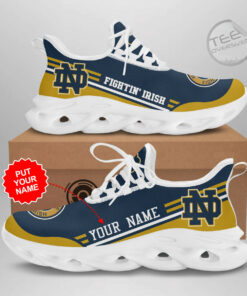
Notre Dame Fighting Irish Sneaker
$85.95 – $85.98
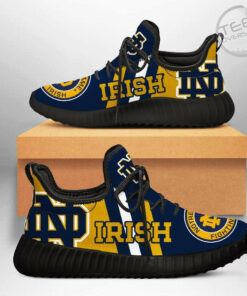
Notre Dame Fighting Irish Custom Sneakers
$89.95 – $89.98
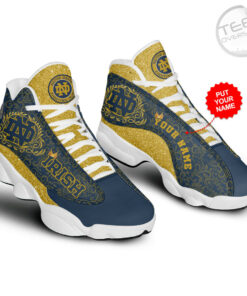
Notre Dame Fighting Irish shoes
$89.95 – $89.98
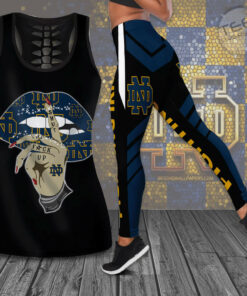
Notre Dame Fighting Irish Hollow Tank Top & Leggings & Bra Sports
$75.95 – $75.98
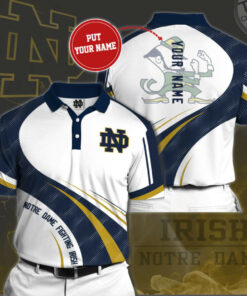
Notre Dame Fighting Irish 3D Polo
$41.95 – $41.98
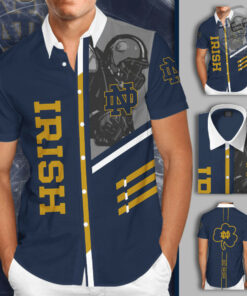
Notre Dame Fighting Irish Short Sleeve Dress Shirt 3D
$35.95 – $35.98
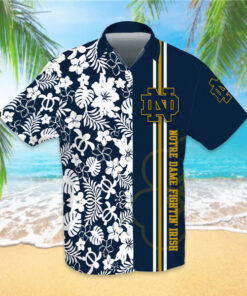
Notre Dame Fighting Irish 3D Hawaiian Shirt, Hawaiian Shorts
$42.95 – $43.95
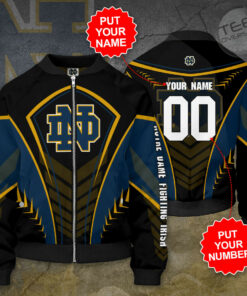
Notre Dame Fighting Irish Bomber Jacket 3D
$54.95 – $59.95
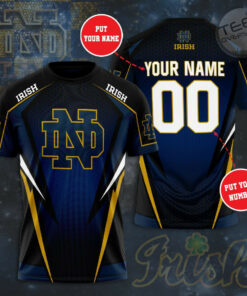
Notre Dame Fighting Irish T-shirt 3D
$29.95 – $29.98
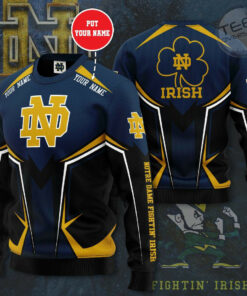
Notre Dame Fighting Irish Sweatshirt 3D
$41.95 – $41.98

Notre Dame Fighting Irish Sweatpant 3D
$45.95 – $45.98

Notre Dame Fighting Irish Hoodie 3D
$45.95 – $45.98
History of the Fighting Irish
Moniker
The exact origin of the moniker "Fighting Irish" is unknown and has been the subject of debates and research. It is first attested as early as 1909, and subsequently became more popular in the 1910s, until it became the official nickname in 1927.
The athletes and teams at Notre Dame were known by many different unofficial names throughout the late 19th and early 20th centuries. During the Knute Rockne football era, Notre Dame had several unofficial nicknames, among them the "Rovers", "Domers", and the "Ramblers". These names reflected the teams' propensity to travel the nation to play its football contests, long before such national travel became the collegiate norm. Later, Notre Dame was known unofficially as the "Terriers," after the Irish breed of the dog, and for some years, an Irish Terrier would be found on the ND football sidelines. Other popular names were “the Gold and Blue”,“Domers”, “Nomads,” “the Blue Comets”, “the Horrible Hibernians”. According to historian Murray Sperber, during the 1910s and 1920s, anti-Catholic and anti-Irish stereotypes and ethnic slurs were openly expressed against immigrants, and the press often referred to Notre Dame teams as "Catholics", "Papists", or "Dirty Irish". University leadership wished to distance itself from such names and school publications referred to the team "the Gold and Blue" or the "Notre Damers".
There are several accounts on the origins of "Fighting Irish." One story suggests the moniker was born in 1899 during a game between Notre Dame and Northwestern. The Fighting Irish were leading 5–0 at halftime when the Wildcat fans began to chant, "Kill the Fighting Irish, kill the Fighting Irish," as the second half opened. In the November 9th, 1912 edition of Scholastic, it is claimed that the monicker "Fighting Irishmen" was given by the president of Illinois University. Another legend in Notre Dame folklore is that the nickname is inherited from Irish immigrant soldiers who fought in the Civil War with the Union's Irish Brigade. Notre Dame's claim to the nickname would seem to come from the presence of Fr. William Corby, CSC, the third president of Notre Dame, who was at the Battle of Gettysburg. Fr. Corby served as chaplain of the Irish Brigade and granted general absolution to the troops in the midst of the battle. This is commemorated in the painting "Absolution Under Fire," part of Notre Dame's permanent art collection. A print of the painting "The Original Fighting Irish" by former Fighting Irish lacrosse player Revere La Noue is on permanent display at Notre Dame's Arlotta Stadium. The print also hangs in the office of former head Notre Dame football coach Brian Kelly, who said that he had to have the work which captures the "swagger" and "toughness" of the football program after seeing it online.
One of the first documented uses of the nickname comes from the Notre Dame-Michigan game in 1909. Reporting on that game, Edward A. Batchelor wrote on the Detroit Free Press: "Eleven fighting Irishmen wrecked the Yost machine this afternoon. These sons of Erin, individually and collectively representing the University of Notre Dame, not only beat the Michigan team, but they dashed some of Michigan's fondest hopes." Notre Dame football historian, John Kryk, later wrote: "With that flowery lead, E.A. Batchelor of the Detroit Free Press popularized a moniker Notre Dame teams would later come to embrace - and aptly summed up the greatest athletic achievement to that point in Notre Dame history." Kryk noted that, according to Notre Dame folklore, Batchelor had overheard a Notre Dame player trying to motivate his teammates at halftime by pleading, "What's the matter with you guys? You're all Irish and you're not fighting worth a lick."
The term Fighting Irish was used in an official capacity by the Notre Dame Football Review as early as 1917 and by Scholastic as early as 1912. While commonly used throughout student and university media at the time, it was still not universally accepted, as evidenced by an alumni letter in Scholastic opposing its use in virtue of the fact that most students did not have an Irish background.
One theory associates the popularity of the nickname to the visit from future president of the Republic of Ireland, Éamon de Valera, who had been part of the 1916 Easter Rising and was imprisoned and sentenced to death. He was given amnesty, elected to Parliament and arrested by the authorities again. He escaped and slipped off to America to avoid recapture. Barnstorming the country, the future president of Ireland was welcomed as a hero at Notre Dame on October 15, 1919. Accounts in Scholastic, a student publication, indicate that his visit tilted campus opinion in favor of the "Fighting Irish" moniker — though not completely. De Valera planted a "tree of liberty" as a memorial of his visit — only to have it uprooted a week later and thrown in one of the campus lakes by a student "of Unionist persuasion."
It has been asserted by Notre Dame alumnus historian Todd Tucker that the moniker became official in large part as a way of honoring and appeasing the student body, after a confrontation with the Ku Klux Klan. The Klan had planned a three-day rally to begin on May 17, 1924. In response to racist and anti-immigration sentiments espoused by the Klan, a large number, between 50 and 500, of Notre Dame students arrived in downtown South Bend to interrupt the Klan's parade with violent harassment. A secondary brawl ensued following the weekend's incident. Rev. Matthew Walsh, C.S.C., then the university president, having addressed the immediate threats of continued violence between the Klan and members of the university, was able to calm the students’ ire and restore relative peace.
Francis Wallace, a student press agent for Knute Rockne and sportswriter, tried to popularize the name “Blue Comets” starting in 1923, but soon gave up and admitted his artificial attempt at a lasting name failed. Instead, he contributed to popularize the use of “Fighting Irish” in the pages of the New York Post and the New York Daily News.
In 1927, university president Rev. Matthew J. Walsh, authorized the moniker "The Fighting Irish" as the official nickname. He stated that "The university authorities are in no way averse to the name ‘Fighting Irish’ as applied to our athletic teams. It seems to embody the spirit that we like to see carried into effect by the various organizations that represent us on the athletic field. I sincerely hope that we may always be worthy of the ideal embodied in the term ‘Fighting Irish."
Conference affiliations
Notre Dame joined the Midwestern City Conference for all sports except football, basketball and hockey in 1982. They remained in the conference, with the exception of the 1986–87 season, until 1995. They were then members of the "old" Big East Conference, basketball included, from 1995 until 2013. The Irish are currently a member of the Atlantic Coast Conference in all sports except for the following:
Football, in which the university maintains its status as an independent university. It is a member of the Football Bowl Subdivision, and for postseason purposes Notre Dame is the only independent with the privileges granted to teams in the Power Five conferences.
Men's ice hockey competes in the Big Ten. Their former hockey conference, the Central Collegiate Hockey Association, disbanded after the 2012–13 season due to a major realignment of hockey conferences. The Irish then spent three seasons as a member of Hockey East before joining the Big Ten.
According to men's basketball coach Mike Brey, Notre Dame strongly considered joining the Big Ten in 2003, with the decision not to proceed occurring at the "11th hour".
Sports sponsored
Football
Head Coach: Marcus Freeman
Stadium: Notre Dame Stadium
National Championships: 11 claimed. There are other years where various mathematical systems and polls selected Notre Dame as a national champion, but those years are not claimed by the university.
The school has a comprehensive and nationally competitive Division I athletic program, but it is most famous for its football program. Notre Dame fielded its first football team in 1887. With eleven football championships acknowledged by the NCAA, over 900 all-time wins, seven Heisman Trophy winners, famous head coaches, a 73% winning percentage and the most consensus All-Americans of any school, Notre Dame football is one of the most storied programs both on the gridiron and college athletics in general. Recently, Notre Dame has struggled, going through several head coaches and setting the all-time bowl losing streak of nine straight with the loss to LSU in the 2007 Sugar Bowl before beating Hawaii in the 2008 Hawaii Bowl. Notre Dame is also the only football program in the nation, including both collegiate and professional ones, with every home game being on national broadcast television.
In addition to having the oldest university marching band in the country, the school has many rivalries in football, the most famous ones being with USC, Navy, Michigan State, Army, Purdue, and Michigan. Notre Dame played in arguably the greatest, although certainly not the most-watched, college football game in history: the famous 10–10 tie against Michigan State at Spartan Stadium on November 19, 1966. Other Notre Dame rivalries include th…
Eye-catching new design Notre Dame Fighting Irish clothing will be the perfect gift for Notre Dame Fighting Irish fans. Clothing on printed with unique and fancy designs, limited number of products.

Notre Dame Fighting Irish Sneaker
$85.95 – $85.98

Notre Dame Fighting Irish Custom Sneakers
$89.95 – $89.98

Notre Dame Fighting Irish shoes
$89.95 – $89.98

Notre Dame Fighting Irish Hollow Tank Top & Leggings & Bra Sports
$75.95 – $75.98

Notre Dame Fighting Irish 3D Polo
$41.95 – $41.98

Notre Dame Fighting Irish Short Sleeve Dress Shirt 3D
$35.95 – $35.98

Notre Dame Fighting Irish 3D Hawaiian Shirt, Hawaiian Shorts
$42.95 – $43.95

Notre Dame Fighting Irish Bomber Jacket 3D
$54.95 – $59.95

Notre Dame Fighting Irish T-shirt 3D
$29.95 – $29.98

Notre Dame Fighting Irish Sweatshirt 3D
$41.95 – $41.98

Notre Dame Fighting Irish Sweatpant 3D
$45.95 – $45.98

Notre Dame Fighting Irish Hoodie 3D
$45.95 – $45.98
Comments
Post a Comment